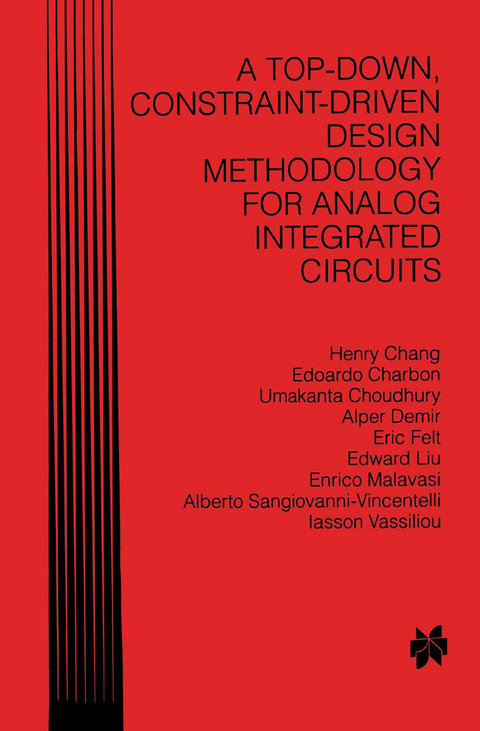
A Top-Down, Constraint-Driven Design Methodology for Analog Integrated Circuits
Seiten
1996
Springer (Verlag)
978-0-7923-9794-6 (ISBN)
Springer (Verlag)
978-0-7923-9794-6 (ISBN)
Analog circuit design is often the bottleneck when designing mixed analog-digital systems. The principal goals are: (1) developing the design methodology, (2) developing and applying new tools, and (3) `proving' the methodology by undertaking `industrial strength' design examples.
Analog circuit design is often the bottleneck when designing mixed analog-digital systems. A Top-Down, Constraint-Driven Design Methodology for Analog Integrated Circuits presents a new methodology based on a top-down, constraint-driven design paradigm that provides a solution to this problem. This methodology has two principal advantages: (1) it provides a high probability for the first silicon which meets all specifications, and (2) it shortens the design cycle.
A Top-Down, Constraint-Driven Design Methodology for Analog Integrated Circuits is part of an ongoing research effort at the University of California at Berkeley in the Electrical Engineering and Computer Sciences Department. Many faculty and students, past and present, are working on this design methodology and its supporting tools. The principal goals are: (1) developing the design methodology, (2) developing and applying new tools, and (3) `proving' the methodology by undertaking `industrial strength' design examples. The work presented here is neither a beginning nor an end in the development of a complete top-down, constraint-driven design methodology, but rather a step in its development.
This work is divided into three parts. Chapter 2 presents the design methodology along with foundation material. Chapters 3-8 describe supporting concepts for the methodology, from behavioral simulation and modeling to circuit module generators. Finally, Chapters 9-11 illustrate the methodology in detail by presenting the entire design cycle through three large-scale examples. These include the design of a current source D/A converter, a Sigma-Delta A/D converter, and a video driver system. Chapter 12 presents conclusions and current research topics.
A Top-Down, Constraint-Driven Design Methodology for Analog Integrated Circuits will be of interest to analog and mixed-signal designers as well as CAD tool developers.
Analog circuit design is often the bottleneck when designing mixed analog-digital systems. A Top-Down, Constraint-Driven Design Methodology for Analog Integrated Circuits presents a new methodology based on a top-down, constraint-driven design paradigm that provides a solution to this problem. This methodology has two principal advantages: (1) it provides a high probability for the first silicon which meets all specifications, and (2) it shortens the design cycle.
A Top-Down, Constraint-Driven Design Methodology for Analog Integrated Circuits is part of an ongoing research effort at the University of California at Berkeley in the Electrical Engineering and Computer Sciences Department. Many faculty and students, past and present, are working on this design methodology and its supporting tools. The principal goals are: (1) developing the design methodology, (2) developing and applying new tools, and (3) `proving' the methodology by undertaking `industrial strength' design examples. The work presented here is neither a beginning nor an end in the development of a complete top-down, constraint-driven design methodology, but rather a step in its development.
This work is divided into three parts. Chapter 2 presents the design methodology along with foundation material. Chapters 3-8 describe supporting concepts for the methodology, from behavioral simulation and modeling to circuit module generators. Finally, Chapters 9-11 illustrate the methodology in detail by presenting the entire design cycle through three large-scale examples. These include the design of a current source D/A converter, a Sigma-Delta A/D converter, and a video driver system. Chapter 12 presents conclusions and current research topics.
A Top-Down, Constraint-Driven Design Methodology for Analog Integrated Circuits will be of interest to analog and mixed-signal designers as well as CAD tool developers.
1 INTRODUCTION.- 2 DESIGN METHODOLOGY.- 3 SIMULATION AND BEHAVIORAL MODELING.- 4 ARCHITECTURAL MAPPING AND OPTIMIZATION.- 5 CONSTRAINT-DRIVEN LAYOUT SYNTHESIS.- 6 BOTTOM-UP VERIFICATION.- 7 TESTING.- 8 MODULE GENERATION.- 9 CURRENT SOURCE DIGITAL-TO-ANALOG CONVERTER DESIGN EXAMPLE.- 10 ?-? ANALOG-TO-DIGITAL CONVERTER DESIGN EXAMPLE.- 11 VIDEO DRIVER DESIGN EXAMPLE.- 12 CONCLUSIONS.- ACKNOWLEDGEMENTS.- REFERENCES.
| Zusatzinfo | VII, 369 p. |
|---|---|
| Verlagsort | Dordrecht |
| Sprache | englisch |
| Maße | 155 x 235 mm |
| Themenwelt | Informatik ► Weitere Themen ► CAD-Programme |
| Technik ► Elektrotechnik / Energietechnik | |
| ISBN-10 | 0-7923-9794-0 / 0792397940 |
| ISBN-13 | 978-0-7923-9794-6 / 9780792397946 |
| Zustand | Neuware |
| Haben Sie eine Frage zum Produkt? |
Mehr entdecken
aus dem Bereich
aus dem Bereich
Buch | Softcover (2023)
Beuth (Verlag)
CHF 138,60
Band 1: Produktion
Buch | Hardcover (2024)
Springer Vieweg (Verlag)
CHF 139,95
Einführung in die Geometrische Produktspezifikation
Buch | Softcover (2023)
Europa-Lehrmittel (Verlag)
CHF 27,90


